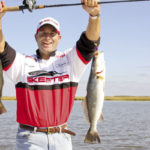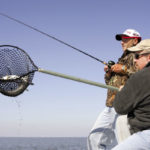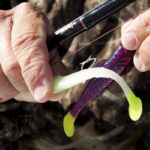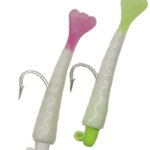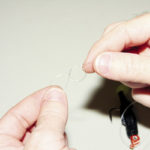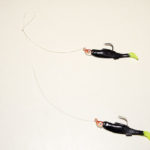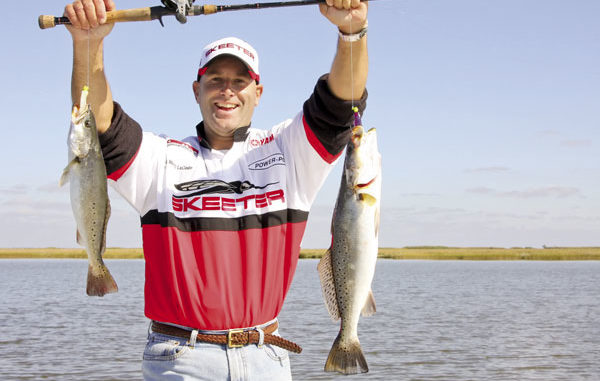
This time of year, wise speckled-trout anglers double their pleasure to double their fun.
Nearly 20 years removed from living in the U.S. Army barracks at Baumholder, Germany, I still can’t get some things that went on there out of my mind. One in particular was courtesy of my little hip-hop wannabe roommate from Florida. This guy wore out one particular disk in his portable CD player with some one-hit-wonders continually belting out, “It takes two to make things go right. It takes two to make it out of sight. Hit it! I wanna rock right now.”
Although I sing those lyrics out loud at least three times a week to the horror of students who have no clue who Rob Base and DJ E-Z Rock are, I was reminded of them again recently during a conversation with DuLarge guide Capt. Bill Lake.
“Are we the only people in Louisiana who throw double rigs?” he asked in amazement as I interviewed him for a Louisiana Sportsman story. “I never read about any of these other guides throwing double rigs. Do they throw them two at a time and just don’t talk about it, or do they not even throw them at all?”
As my mind gyrated back to Germany circa 1990, I realized Lake was right. The only people I ever heard mention throwing two baits at a time were the guides from southern Terrebonne Parish. And they didn’t just bring up double rigs every now and then; they doted on them every time we talked.
Other than Lake, Capt. Marty LaCoste with Absolute Fishing Charters also feels alone when it comes to double rigs. He grew up learning to fish double rigs with his family out of Cocodrie, and, in the 25 years since, he has found very few reasons to put them down.
LaCoste has also put together some very sound reasons on why he favors double rigs over single rigs while staying smart enough to know when to put down the double and pick up a single bait.
“I fish double rigs to be able to give customers a better chance of catching a limit,” said LaCoste. “Common sense says that if you have two baits in the water you can catch trout twice as fast as if you only had one bait in the water.”
But it’s not only about putting numbers in the box; it’s also a matter of timing. Knowing the propensity of a trout bite to instantly turn on and off, throwing double rigs allows him to take advantage of the evanescent bite when it does turn on.
“You can be out fishing and catching fish every cast, and — boom — like a light they turn off,” LaCoste said. “If you’re catching them two at a time versus one at a time, you’re going to increase your chances of limiting out faster before they shut off.”
Although most Louisiana saltwater anglers old enough to buy their own baits have seen the shelves stocked with packages holding two baits tied together, just as many have passed them for the bags of single soft plastics.
Both are important parts of our saltwater tackleboxes, but knowing when, where and how to fish one over the other is what can turn a so-so day into a spectacular one. Knowing how to fish double rigs begins with understanding how to tie them or realizing that you can’t.
“I do both,” said LaCoste in response to whether he tied his own double rigs or purchased them already tied. “If I have time, I tie them myself, but if I don’t, and I’m short on them, I buy them. I would rather tie them myself to save the money, but the pre-tied ones can come in handy.”
In fact, Texas Tackle Factory (TTF) pro staff member Jason Bryant relies almost exclusively on pretied TTF tandem rigs like the Lil’ Speck Killers and Double Shad Rigs. Bryant, who regularly fishes the TTF tandem rigs at Sabine Lake in Southwest Louisiana, brought up a few reasons why he likes these as opposed to tying his own.
“They’re much simpler,” he said. “You’re guaranteed that the rig will be tied correctly. Tying your own tandem rigs can take a lot of time, and it’s easy to mess up if your knots aren’t perfect. And the heavy mono on the TTF rigs helps to keep the baits from spinning and tangling together during the retrieve.”
Whether you buy them or tie them, tandem rigs are productive more days than they are not. In fact, LaCoste says the only time he doesn’t fish them is during the coldest part of the winter when sluggish trout hug the bottom of deep canals.
Other than that, he always checks to see if he can catch trout two at a time before he resorts to throwing a single bait.
“For me, double rigs are what you throw under the birds in late September, October and November,” LaCoste said. “And then again in February and March. Under the birds — double rigs no matter what. I also throw them all summer long offshore fishing the surf around the islands and on all the rigs.”
Although LaCoste has some preferred times of year to fish double rigs, he would never hamstring himself to just those months. Rather than being a rig for certain months, LaCoste considered them to be rigs for certain circumstances.
“When the double-rig bite is on, you don’t even have to work your baits,” LaCoste said. “Most of the time, two trout will pick up your baits as soon as they hit the water. That’s why they’re so good under birds. And you get the same feeding frenzy some times out on the rigs when the trout are active near the surface.
“So the key to knowing when to fish them is realizing when you’re on a bunch of feeding fish. If you’re throwing a single rig, and you’re getting hit as soon as it hits the water, tie on a double rig, and you’ll double your chances.”
Bryant also thinks of his tandem rigs as a situational rig rather than a seasonal one. Although he knows tandem rigs have a reputation for being the ideal bait under the lights at night, that’s not the only time he uses them. In contrast to LaCoste, Bryant likes tandem rigs when the fish aren’t as aggressive.
“I almost always have a tandem rig tied on during the fall,” he said. “Also, any time I notice an abundance of small shrimp in an area I’m fishing. Other than that, I think tandem rigs are perfect during post-front, bluebird days when fish are lethargic or wary. I joke to people that a spinning rod combined with a tandem rig is a poor man’s fly rod.”
Fishing double rigs isn’t that much different than fishing single baits, but there are some things you can focus on to make you a better double-rig angler. LaCoste loves it when trout eat his baits as soon as they hit the water, but he also knows that won’t always be the case
“If they don’t immediately hit my baits,” he began, “I like to work from the bottom up. First, I let my baits go to the bottom and crawl them with a steady retrieve — maybe a little bump every now and then. Then I go to a medium retrieve to work the middle of the water.”
When he’s at the rigs, especially, LaCoste says another retrieve that works well for him is to let his baits go down where he just holds them in the current. Without even reeling, the current will naturally wash the baits into a position that holds them right off the bottom and spread out to look like two baitfish.
Speaking of two baitfish, Bryant has a little trick he uses that appeals to the age-old competitive instinct of a predator fish to eat a bait before another fish can get to it. Using the TTF Lil’ Speck Killer, he removes the bottom plastic and replaces it with a larger one like the TTF Killer Flats Minnow, Big Mino or Trout Killer.
“When retrieved, it looks like a small fish chasing a shrimp,” Bryant explained. “This triggers the competitive instinct in predatory fish, and oftentimes they’ll eat the chaser bait. I’ve found this works especially well on big, lethargic trout in cold weather. There may not be a better tactic for enticing a reaction strike.”
Bryant passed along a little tip for fishing tandem rigs this way. Try cutting off the 1/8-ounce jighead on the bottom and replacing it with a 1/4- or 3/8-ounce head so that the larger bait always trails the smaller one. He says this set up really makes the front bait dance, too.
“The best advice I can give to someone who doesn’t use tandem rigs often is to be patient [if the trout aren’t eating as soon as they hit the water],” Bryant said. “The light heads and heavy mono that are characteristic of most tandem rigs make for a slow-sinking presentation.
“Let the rig flutter to the bottom and then snap it up in short, quick jerks. Don’t be afraid to scoot it along the bottom, either. You can draw a lot of attention with tandem rigs by using them to stir up mud and silt on the bottom.”
Lake might think the DuLarge guides are the only people throwing tandem rigs, but they are not alone. Anglers all across coastal Louisiana have been throwing them for years, especially those that might be a little more old school than others.
They’ve known all along that it sometimes takes two to turn on the bite.
